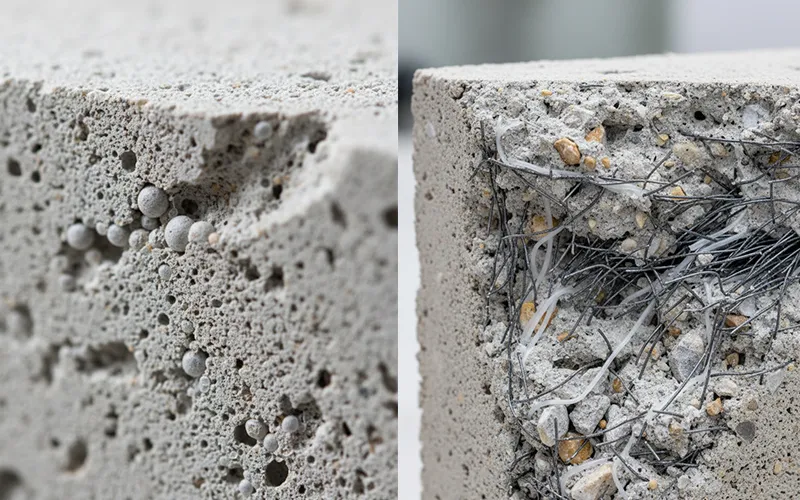Learn when to specify air-entrained or fibre-reinforced concrete. Concrete Shopper helps you choose durable, cost-effective mixes for any project.
Selecting the right concrete mix is vital for durability, strength, and cost-effectiveness in residential and commercial projects. Two common options are air-entrained concrete and fibre-reinforced concrete, each offering distinct benefits. This article outlines their characteristics, applications, and advantages to help you choose the most suitable mix for long-lasting results.
What is Air-Entrained Concrete?
Air-entrained concrete contains microscopic air bubbles introduced through chemical admixtures, which act as relief points when water freezes and expands, reducing cracks and spalling. This makes it highly effective in freeze–thaw environments while also improving workability by enhancing flow, reducing segregation, and minimising bleeding. However, it can slightly reduce compressive strength, so careful specification is required.
What is Fibre-Reinforced Concrete (FRC)?
This type of concrete is produced by adding fibres such as steel, synthetic, glass, or natural materials to enhance tensile strength and reduce cracking. These fibres bridge small fissures, controlling shrinkage, improving impact resistance, and extending the structure’s service life. With different fibre types offering tailored benefits, it provides a versatile solution for projects that demand durability, toughness, and reduced maintenance.
When to Specify Air-Entrained Concrete
Air-entrained concrete should be specified when a structure is expected to face harsh weather conditions, particularly repeated cycles of freezing and thawing. Outdoor applications such as driveways, pavements, and exposed structural elements benefit greatly from its durability.
It is also recommended where improved workability is a priority, as air entrainment assists in achieving smoother placement and finishing. However, care should be taken when using air-entrained concrete for highly polished interior floors or surfaces requiring dense finishes, as the air bubbles can compromise surface integrity.
When to Specify Fibre-Reinforced Concrete
Fibre-reinforced concrete is ideal when crack control, structural toughness, and long-term resilience are required. Fibres reduce shrinkage cracks during curing and deliver superior performance under tensile and impact stresses. This makes FRC highly suitable for industrial slabs, pavements, bridge decks, and driveways subject to heavy traffic.
In addition, fibre-reinforced materials can improve efficiency on-site by reducing or replacing the need for traditional steel mesh reinforcement. This results in faster placement, safer handling, and lower labour costs. For projects that demand both performance and productivity, FRC offers significant advantages.
Choosing Between the Two – or Using Both?
| Feature / Benefit | Air-Entrained Concrete | Fibre-Reinforced Concrete |
| Primary Function | Freeze–thaw durability | Crack control and structural toughness |
| Durability | Excellent against weathering and moisture | Superior under load and impact |
| Workability | Improved flow and placement | Slightly less flow, more structural resilience |
| Applications | Outdoor pavements, driveways, and exposed elements | Slabs, industrial floors, bridge decks, driveways |
| Limitations | Reduced compressive strength, finish sensitivity | Higher material cost depending on fibre type |
While both options are valuable, it is often the more versatile solution. Its ability to control cracking, reduce maintenance, and eliminate or reduce the need for steel reinforcement makes it suitable for a wide range of Australian projects, from residential driveways to large-scale infrastructure.
Why Builders and Contractors Trust Concrete Shopper
At Concrete Shopper, we specialise in supplying the right concrete mix tailored to Australian conditions. Our extensive supplier network ensures reliable delivery, competitive pricing, and expert support. Whether your project requires air-entrained concrete or fibre-reinforced concrete, we help you make the right specification with confidence.
Contact us today for tailored advice or plan your next project with confidence using our Concrete Calculator.
Related Blog Articles:
Concrete Mix Supplier: Ensuring Strength and Reliability in Every Mix
Best Concrete Supplier in Australia: Premium Ready Mix Concrete Delivery


